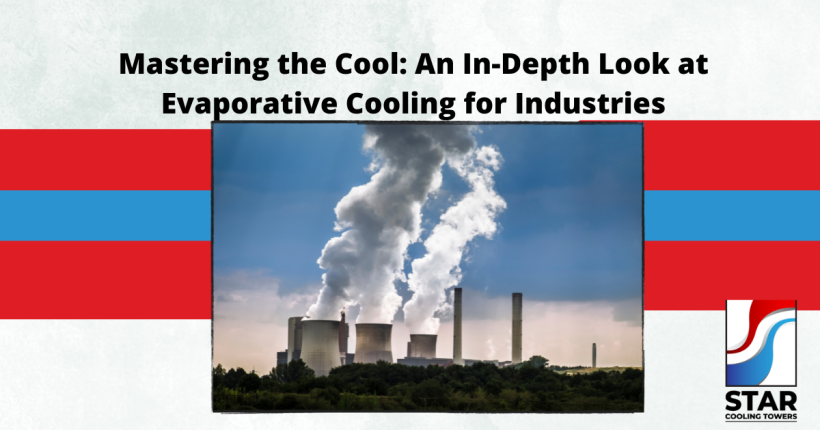In the relentless domain of industry, maintaining optimal environmental conditions is not a luxury but a necessity. Stalwarts of business acknowledge that the art of cooling isn’t merely about comfort; it’s about performance, energy efficiency, and long-term viability.
In the quest for the ideal climate control solution, evaporative coolers stand out as a formidable option, distinguished by their product integrity, energy efficiency, and environmental benefits.
This in-depth exploration into evaporative cooling is tailored for industrial and commercial moguls ready to arm themselves with the latest advances in environmental engineering.
Evaporative Cooling Process
Evaporative cooling technology fundamentally utilizes the ancient principle of heat transfer through evaporation to reduce the temperature of air entering a specific area.
This phenomenon is as potent as it is graceful, grounded in the straightforward principle that the transition of water from liquid to gas removes energy—specifically, heat exchanger—from the surrounding air. Though seemingly simple, this process is remarkably efficient and revolutionizes how industries meet their cooling requirements.
Delving into the Science Behind It
Direct evaporative cooling begins by saturating air with water, typically through a medium such as wet pads, or through a direct or indirect solution. This moistened air, at a lower temperature due to the energy taken to evaporate the water, is then circulated through the industrial space, lowering the overall temperature. Surprisingly, this mechanism isn’t a newcomer to the realm of cooling towers; it is just often underappreciated for its efficiency and capacity to handle vast spaces.
The Benefits of Going Evaporative
The advantages of evaporative cooling are both multifaceted and weighty. From slashing energy bills by a significant margin to being a green alternative in water consumption, the list of merits is compelling. When pitted against conventional air conditioning methods, evaporative cooling often outshines in terms of both initial cost and long-term operational savings.
Industry Applications of Evaporative Cooling
No less significant are the diverse applications that make evaporative cooling a chameleon in the industrial landscape. It can be found in data centers, manufacturing floors, and open-air facilities alike, delivering bespoke solutions for each. One such example is in the realm of agribusiness, where maintaining the perfect humidity level is a matter of crop preservation and yield enhancement.
Evaporative coolers, often referred to as “swamp coolers,” embody an eco-friendly approach to cooling, leveraging the natural process of water evaporation to cool air efficiently. These systems are particularly suitable for areas with low humidity, where they operate most effectively.
By drawing in warm air and passing it over water-saturated pads, the air’s temperature drops as water evaporates, thus emitting cooler air into the environment. This method not only reduces the temperature but also adds moisture to the air, which can be a boon in arid regions.
Unlike traditional air conditioning systems that rely on chemical refrigerants and consume significant amounts of energy, evaporative coolers provide a sustainable alternative, aligning with the growing trend towards greener, more energy-efficient solutions in industrial settings.
Evaporative Cooling vs. Air Conditioning
Comparing evaporative cooling to central air conditioners reveals stark differences in approach, impact, and environmental footprint. While air conditioning has its place, especially in high-humidity scenarios, evaporative cooling’s resourcefulness cannot be overstated.
What to Consider Before Making the Switch
Implementing an evaporative cooling system is a strategic decision that demands thorough consideration. From the local climate’s suitability to the water quality and even the size of the structure, a series of factors should be examined. It’s not a one-size-fits-all scenario, and careful planning can be the difference between a triumph and a lukewarm result.
Cooling Tower
Cooling towers, often associated with evaporative cooler systems, play a critical role in expelling heat load from various processes or the building’s air conditioning system to the atmosphere.
Unlike direct evaporative cooling, which involves the direct contact of water with the air to reduce air temperature, cooling towers use water evaporation within a tower to remove process heat and cool the working fluid to near the wet-bulb air temperature.
These structures are both practical and efficient, playing a vital role in industries where cooling is imperative but must be achieved with minimal water and energy consumption. The integration of cooling towers with evaporative cooling technologies exemplifies a comprehensive strategy towards industrial thermal management, highlighting a commitment to sustainability and enhanced operational efficiency.
Conclusion
For businesses navigating the complexities of environmental management, evaporative cooling offers a beacon of hope. It marks the intersection of sustainability and innovation, promising a cool tomorrow for enterprise. Whether you’re a small factory on the rise or a titan of production, the power of evaporative cooling can transform not just your air, but your bottom line. It’s time to step into the refreshing world of evaporative cooling and steer your industrial destiny toward cool and responsible horizons.


